Why Israel Was Attacked From Gaza — @RealLifeLore
@RealLifeLore Infographic Summary
Table of Contents
- Relations Between Saudi Arabia, Iran, and Israel | 0:00:00-0:03:00
- Current Situation in Gaza City | 0:03:00-0:15:20
- Benjamin Netanyahu Becomes Israel’s Prime Minister in 1996 | 0:15:20-0:17:20
- Current Events in the Gaza Strip | 0:17:20-0:30:40
- Israeli Annexation of the West Bank: Reactions and Rejections | 0:30:40-0:37:00
- Israel’s Recognition in the Arab World and Palestinian Statehood | 0:37:00-0:45:00
- Geopolitics Between Russia, Saudi Arabia, Israel, and Iran | 0:45:00-0:54:20
- Hamas Roles and Relationships | 0:54:20-0:56:40
https://youtu.be/7Jyc-LzXqk0
Relations Between Saudi Arabia, Iran, and Israel | 0:00:00-0:03:00
Saudi Arabia and Iran had finally agreed on restoring their relations in March of 2023, after having been severed six years previously. Brokered by America, Saudi Arabia and Israel were also on the cusp of normalizing their relations. Iran’s attacks against American military bases had stopped, and there was a general sense in much of the world that the chronically violent and unstable Middle East was at last beginning to calm down and enter into a new era of peace.
Jake Sullivan himself summed up the general foreign policy mood in the region during that speech on the 29th of September, when he said the following about Iran’s nuclear weapons program and the tensions between Israelis and Palestinians. “The amount of time that I have to spend on crisis and conflict in the Middle East today compared to any of my predecessors going back to 911 is significantly reduced.” It would only take two weeks for those words to immediately come back and haunt him. On the 7th of October 2023, various Palestinian militant groups led by Hamas, the organization who rules in the Gaza Strip, launched a highly coordinated surprise land, sea, and air offensive against Israel. They managed to fire at least 5,000 rockets against Israel, while around 2,500 armed Hamas fighters managed to break through the wall’s surrounding, surrounding Gaza and infiltrated into multiple villages of Israel itself, where they massacred at least 1,400 Israelis and other citizens in a single day, wounded more than 5,000 others, and took around 200 more as hostages back into Gaza. The attack represented the single bloodiest day in the entire history of Israel, and the first time since 1948 that a hostile outside military power managed to break into Israel proper. It all came as a profound shock to the State of Israel, which has since responded with an unprecedented declaration of war against Hamas in Gaza, that was followed up by the rapid mobilization of 300,000 Israeli reserve troops, and quickest call up of reserves in Israel’s entire history.
The 16 year long Israeli blockade of Gaza then subsequently transformed into a complete and total Israeli siege of Gaza, with the Israelis blocking off all electricity, fuel, telecommunications, water, and medicine from passing into Gaza through any of their territory by land, sea, or air. The Israeli Air Force began initiating a punishing aerial campaign across the Gaza Strip that saw more than 6,000 Israeli bombs dropped across the territory within only the first six days of the war beginning. More than double the amount of ordnance that the United States-led coalition dropped in an entire month in the war against ISIS. Israeli airstrikes continued on the 13th of October, Israel ordered that more than 1.1 million Palestinians immediately evacuate from the northern Gaza Strip towards the southern Gaza Strip within 24 hours or be potentially considered as enemy combatants. And then two weeks later on the 27th of October, the Israeli ground forces launched their full scale invasion into the northern Gaza Strip.
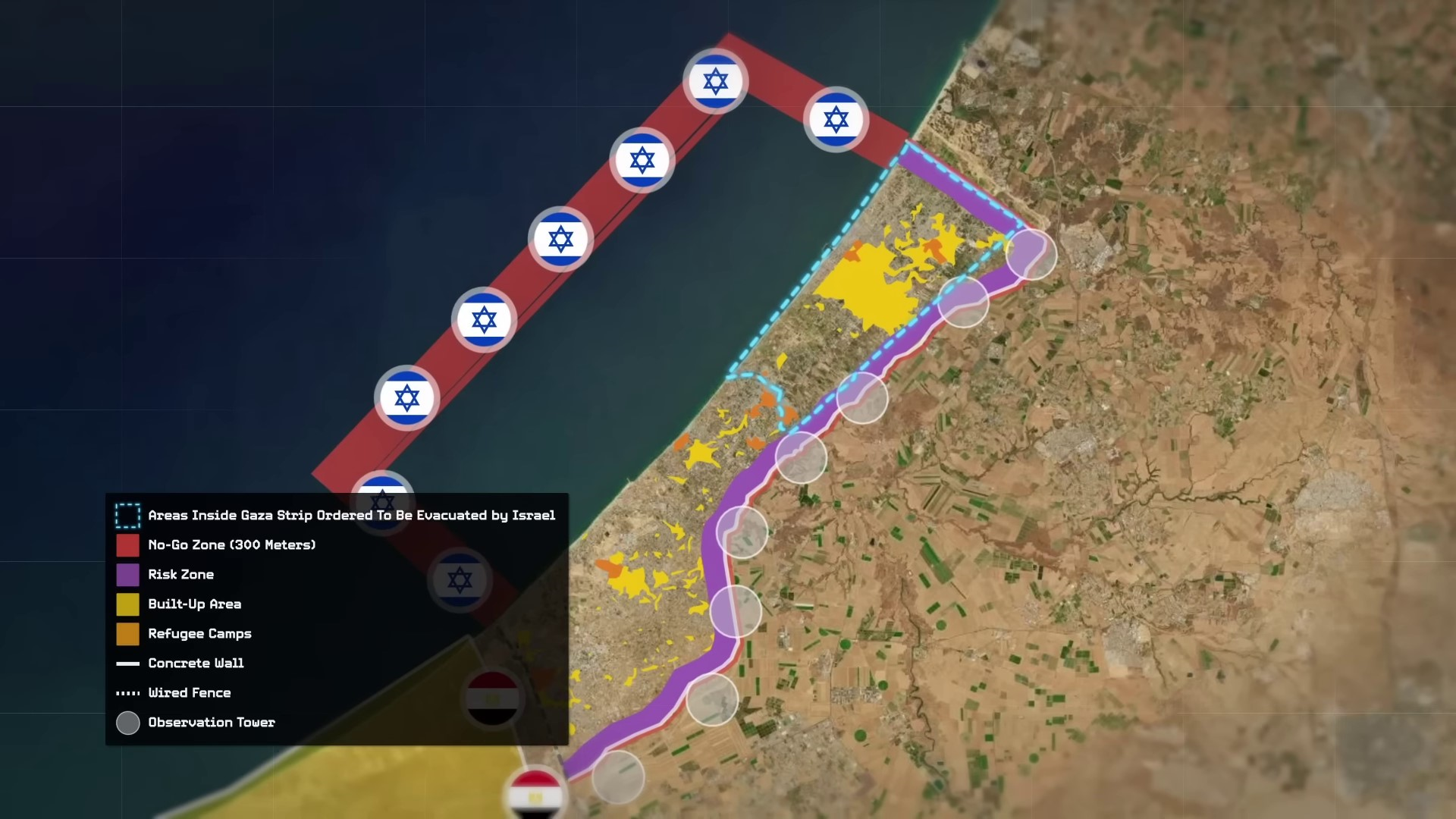
Timeline of Event in Gaza City | 0:03:00-0:15:20
As of the production of the video, Gaza City, the largest city in Palestine, is completely encircled by Israeli forces. The Israeli military objective is to destroy Hamas and secure the release of hostages. The Gaza Health Ministry reports thousands of Palestinian casualties. The conflict has escalated into a catastrophic war in the Middle East, risking wider regional involvement. The roots of the conflict trace back to the British Empire’s acquisition of Mandatory Palestine after World War I, with increasing Jewish immigration amid rising anti-Semitism in Europe.
The establishment of an independent Jewish state in Mandatory Palestine has led to conflict between Jewish and Arab groups. The British supported the creation of a Jewish state but faced opposition from both sides. The United Nations proposed a partition plan in 1947, leading to war between Israel and Arab states. Israel won the war and established control over Palestinian territories, leading to the displacement of many Palestinians. Meanwhile, Jewish communities in the Muslim world faced challenges as well.
Over the decades that followed as Israel established itself further, the vast majority of them were either forcibly expelled, fled, or voluntarily migrated away. The Jewish exodus away from the Muslim world and largely towards Israel has resulted in fewer than 30,000 Jews continuing to live in the Muslim world today, down from around a million in 1948. Today, these Middle Eastern and North African Jews who left, and their descendants, comprise more than 50% of the Israeli Jewish population. This is the country’s single largest ethnic group today, while another 32% of the Israeli Jewish population are of Ashkenazi ancestry from Eastern and Central Europe, who represent the second largest group.
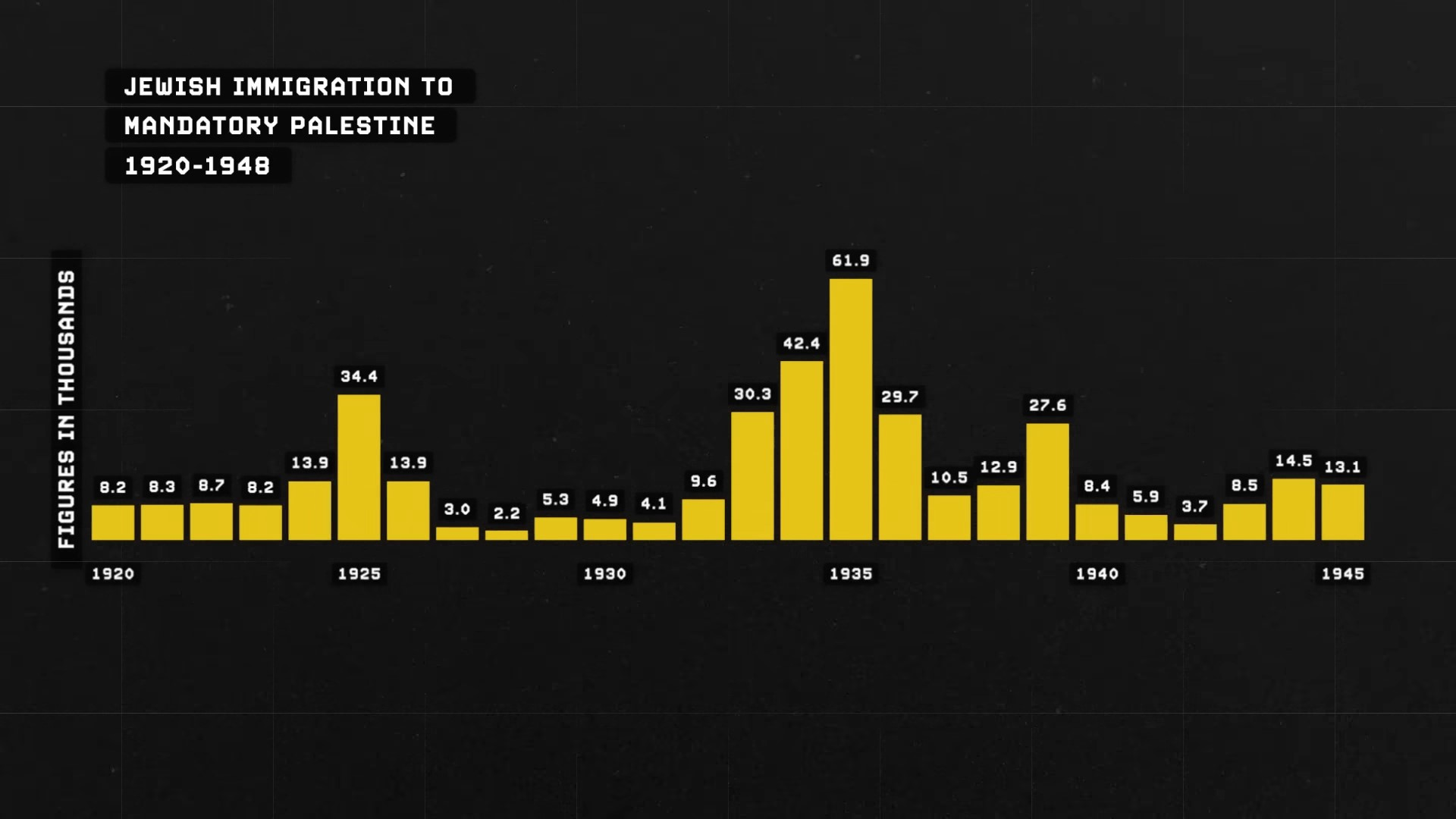
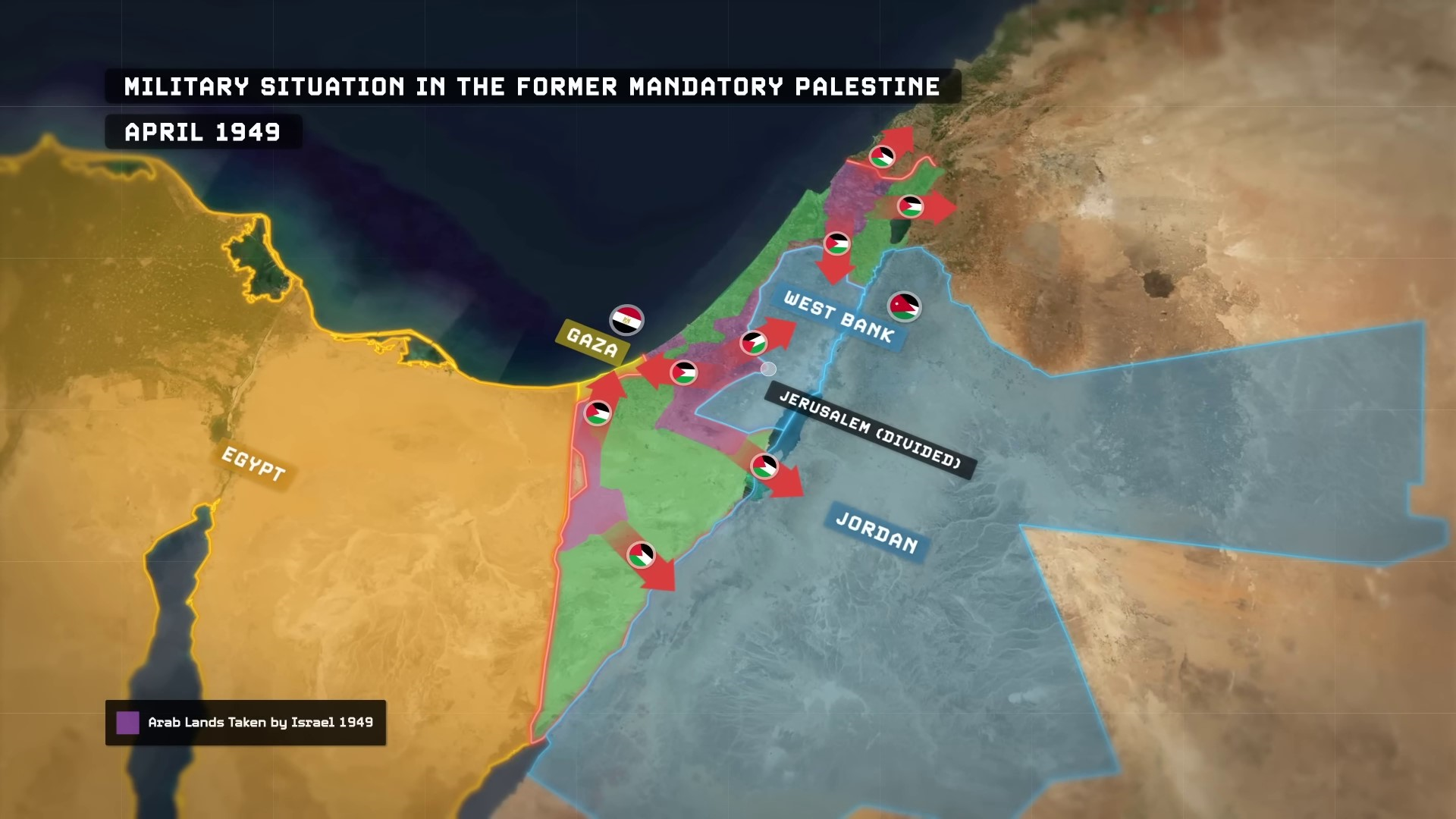
Both the Palestinians and the Israelis have struggled defining where one of their territories begins and the other ends, within the overall territory of the former British mandate, and have struggled with achieving universal recognition by the outside world.
Israel’s ‘mostly’ internationally recognized boundaries, today, consist of that so-called Green Line dating back to 1949, but there were also the additional territories that came under Israel’s control during the later Six-Day War of 1967 that lay beyond on the 1949 Armistice Green Line. The United Nations Security Council passed Resolution 242, which effectively considered these new territories as ‘occupied territories’ and that the Israelis should immediately withdraw from them. This led to the Arab League convening at Khartoum in Sudan, where they proclaimed the 1967 Khartoum Resolution, explicitly laying out their foreign policy towards Israel, going forward.
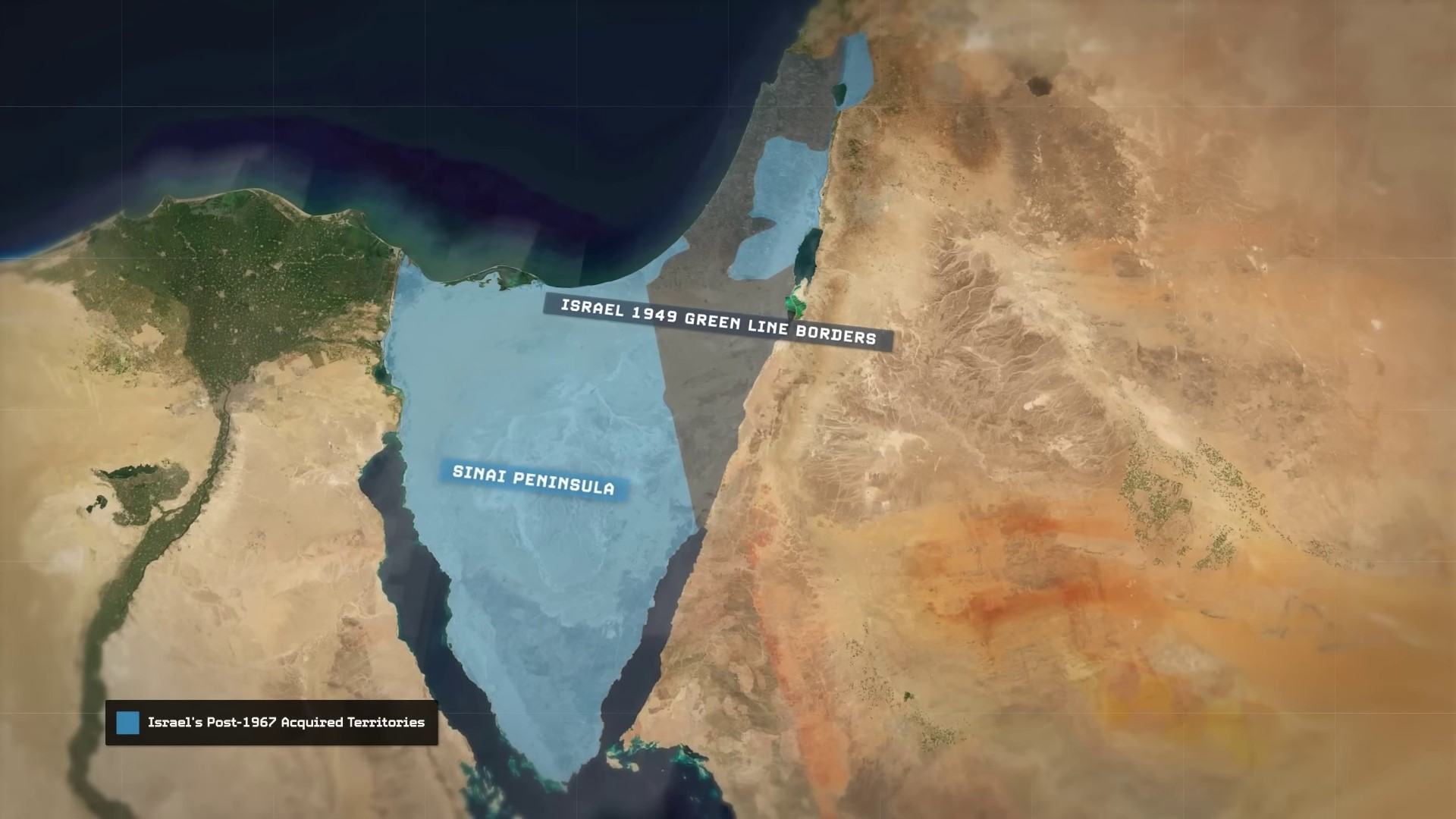
The Arab world’s three-no’s policy, established after the 1967 Khartoum Resolution, rejected peace, recognition, and negotiations with Israel. However, Egypt broke this stance by signing a peace treaty with Israel in 1979, leading to the return of the Sinai Peninsula. Israel later annexed East Jerusalem and the Golan Heights, and their actions were condemned by the United Nations. The West Bank and Gaza Strip were treated differently, with Egypt and Jordan renouncing claims to them in peace agreements with Israel. Despite these agreements, Israel’s occupation of these territories remained internationally unrecognized.

The Israeli-Palestinian conflict has left Palestinian territories in a state of legal limbo for decades, with Israeli settlers displacing and angering Palestinians. The Oslo Accords of 1993 and 1994 established the Palestinian Authority as an interim government, which aimed for a future independent state of Palestine. The agreement divided the West Bank into areas with different levels of control between the Palestinian Authority and Israeli Military and State.
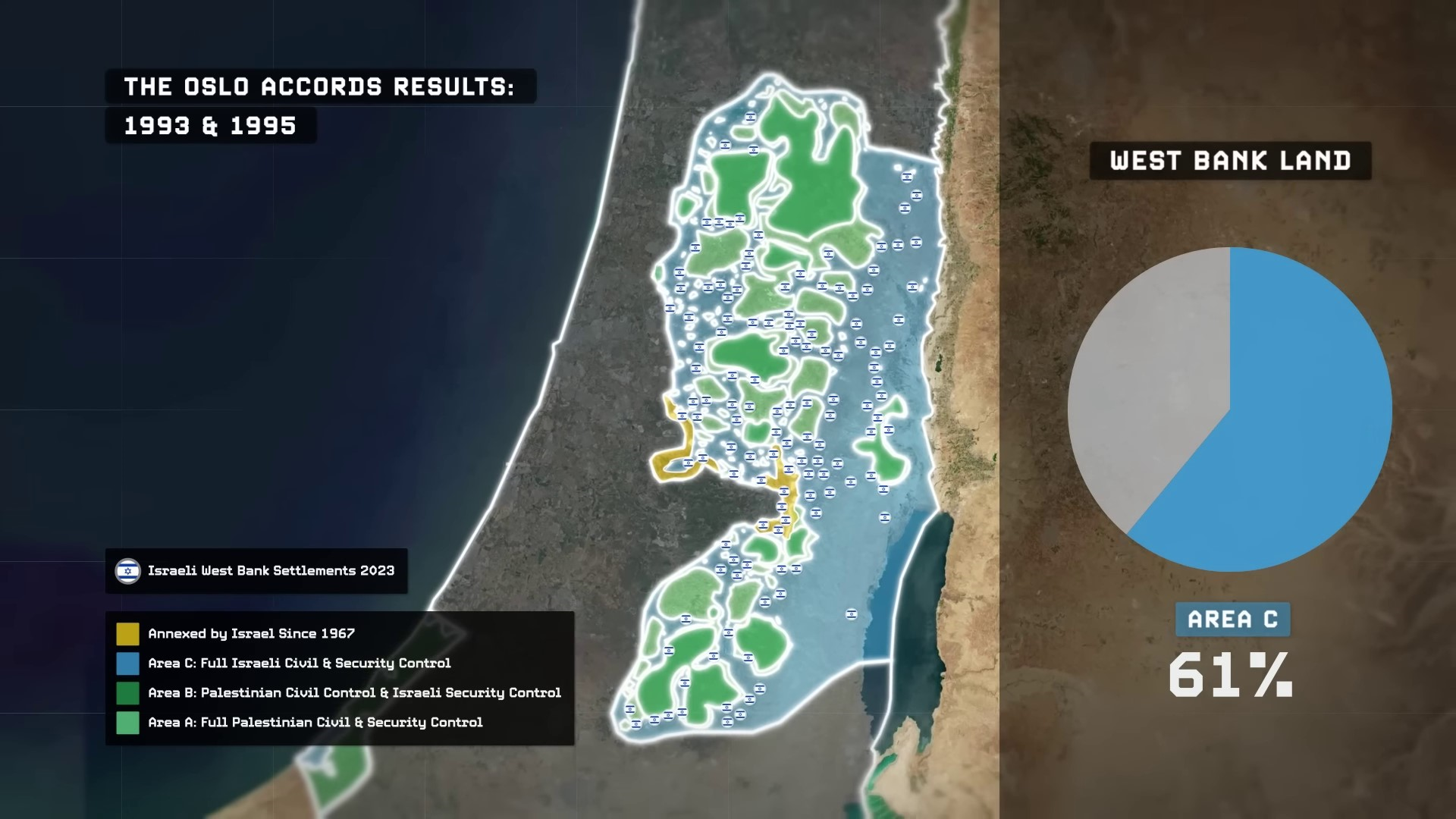
The West Bank is divided into three areas: Area A under Palestinian civil and security administration, Area B under Palestinian civil administration and Israeli security administration, and Area C under full Israeli control. Area C comprises 61% of the West Bank and is home to Israeli settlements. The Oslo Accords intended for Area C to be transferred to Palestinian control, but this has not happened. The division has been compared to apartheid in South Africa. Yitzhak Rabin, who signed the Oslo II Accord establishing the areas, was assassinated by an Israeli extremist opposed to Palestinian independence.
Current Events in the Gaza Strip | 0:15:20-0:30:40
In 1996, Benjamin Netanyahu became Israel’s Prime Minister, leading to a halt in negotiations with the Palestinian Authority. The division decisions in the West Bank since 1995 have remained unresolved, with Israeli settlers increasing in Area C. As of 2023, there are around 230,000 Israeli settlers in East Jerusalem and 470,000 in Area C of the West Bank. Palestinians in Area C are under Israeli military rule, while others live in Areas A and B under Palestinian Authority control. Israel’s control over the West Bank and settlements have raised concerns about violations of international law. By 2005, Israel had settlers in 21 settlements in the Gaza Strip.
The situation in the Gaza Strip became untenable due to its small size and high population density. After Hamas won the 2006 elections, a division emerged within the Palestinian leadership between Hamas in Gaza and Fatah in the West Bank. Israel responded with a blockade on the Gaza Strip in 2007. Gaza became surrounded by a blockade enforced by Israel and Egypt, with high walls, barbed wire, motion sensors, and robotic machine guns on the land border. The Israeli Navy enforces a maritime no-go zone, and the Israeli Air Force enforces a no-fly zone over Gaza. The blockade aims to restrict Hamas from importing weapons, economically strangle the government, and pressure it to moderate its position. This has led to a permanent scarcity of resources and supplies, causing unrest among Palestinians. The blockade has been in place for 16 years.
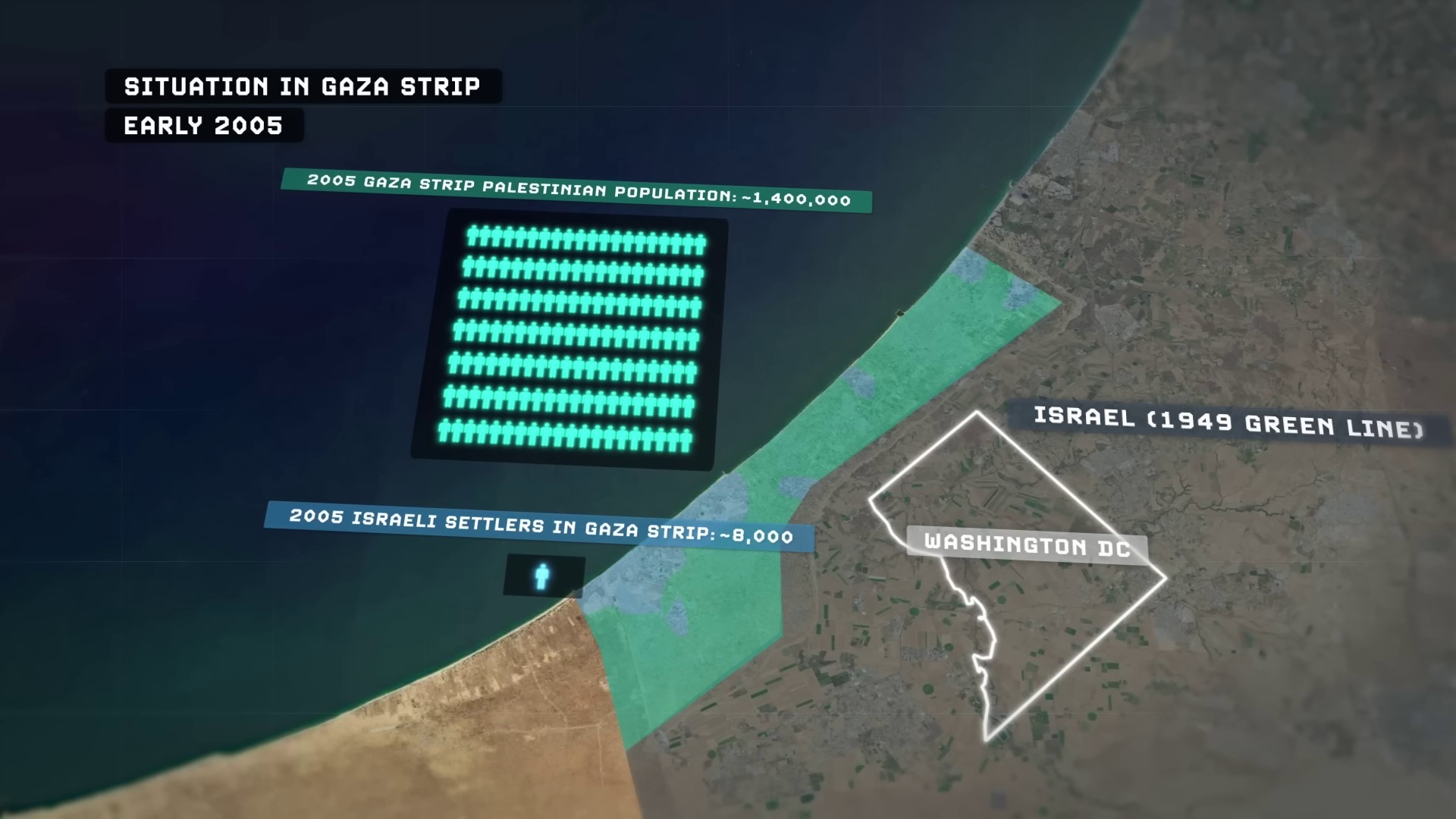
Hamas has not moderated its position or collapsed from power since 2007, leading to frequent fighting with Israel. The joint Israeli-Egyptian blockade on Gaza has been ongoing for 16 years, labeled as a humanitarian catastrophe. Human rights advocates criticize it as collective punishment, while Israel argues it is for self-defense. Gaza’s population has grown from 1.4 million in 2007 to 2.2 million in 2023, with 40% being children born during the blockade.

The Gaza Strip, under the control of Hamas and surrounded by the Israeli military, is described as an open-air prison due to its high population density, poverty, hunger, and resource scarcity. Residents face restrictions on leaving and limited opportunities for advancement, leading to a sense of confinement and limited aspirations.
Between 2007 and 2017, Israel and Palestine were in a complex geopolitical state. Israel managed its post-1967 acquired territories with a blockade around the Gaza Strip and increased settlers in the West Bank’s Area C. There were talks of annexing parts of the West Bank, East Jerusalem, and the Golan Heights. Israel maintained international recognition based on the 1949 Green Line armistice borders with most countries.
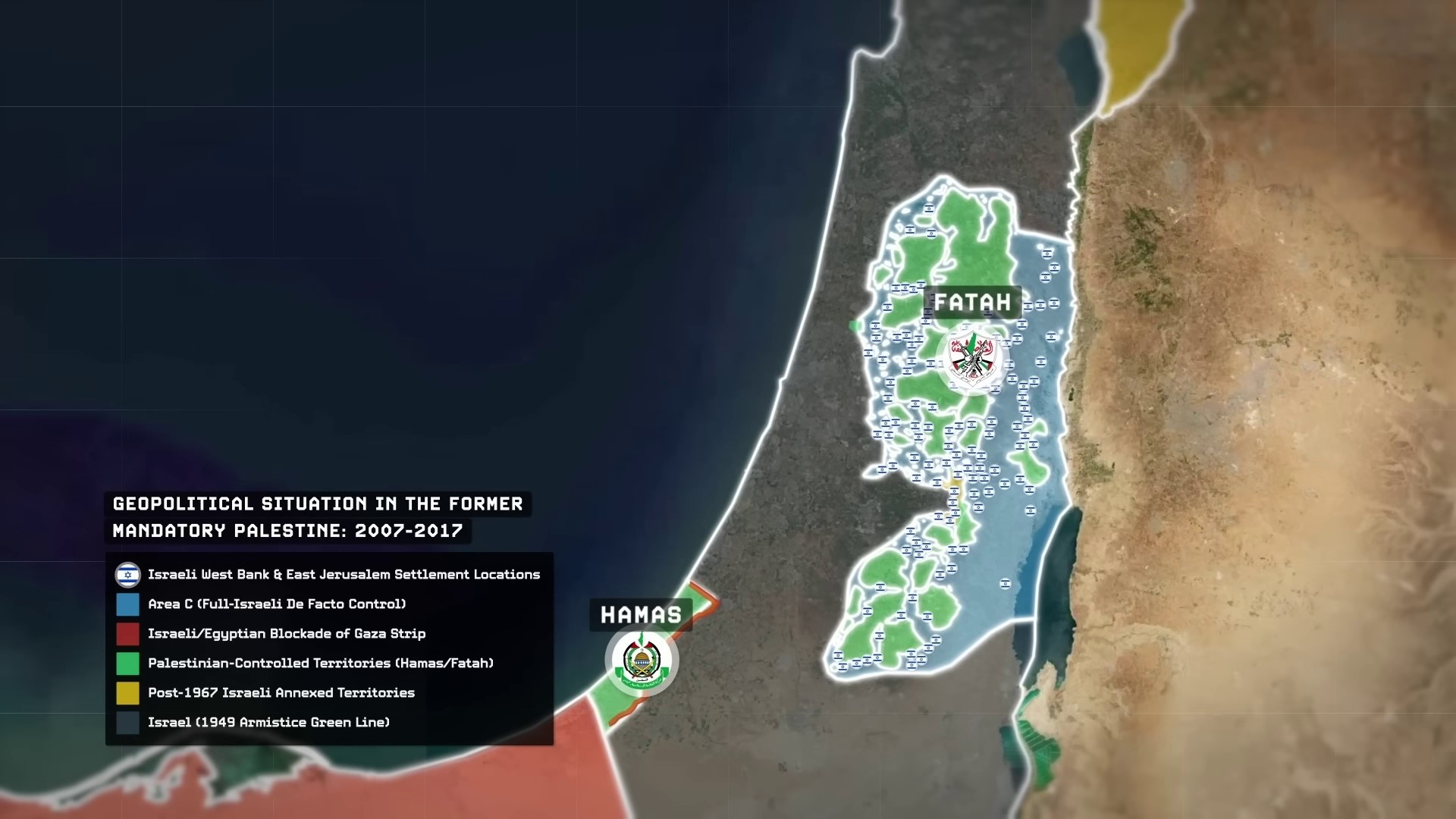
The Arab and Muslim worlds, along with some anti-colonial or anti-western socialist states, have largely never recognized Israel’s existence since 1948. Egypt and Jordan are the only Arab states that have recognized Israel and made peace. Other Arab states continue to support Palestinians and the Khartoum Resolution. The state of Palestine claims the West Bank, East Jerusalem, and Gaza Strip, recognized by most of the world and granted observer status at the UN in 2012. However, this new entity lacked official recognition from Israel, the United States, Canada, Australia, Japan, and most of Western Europe.
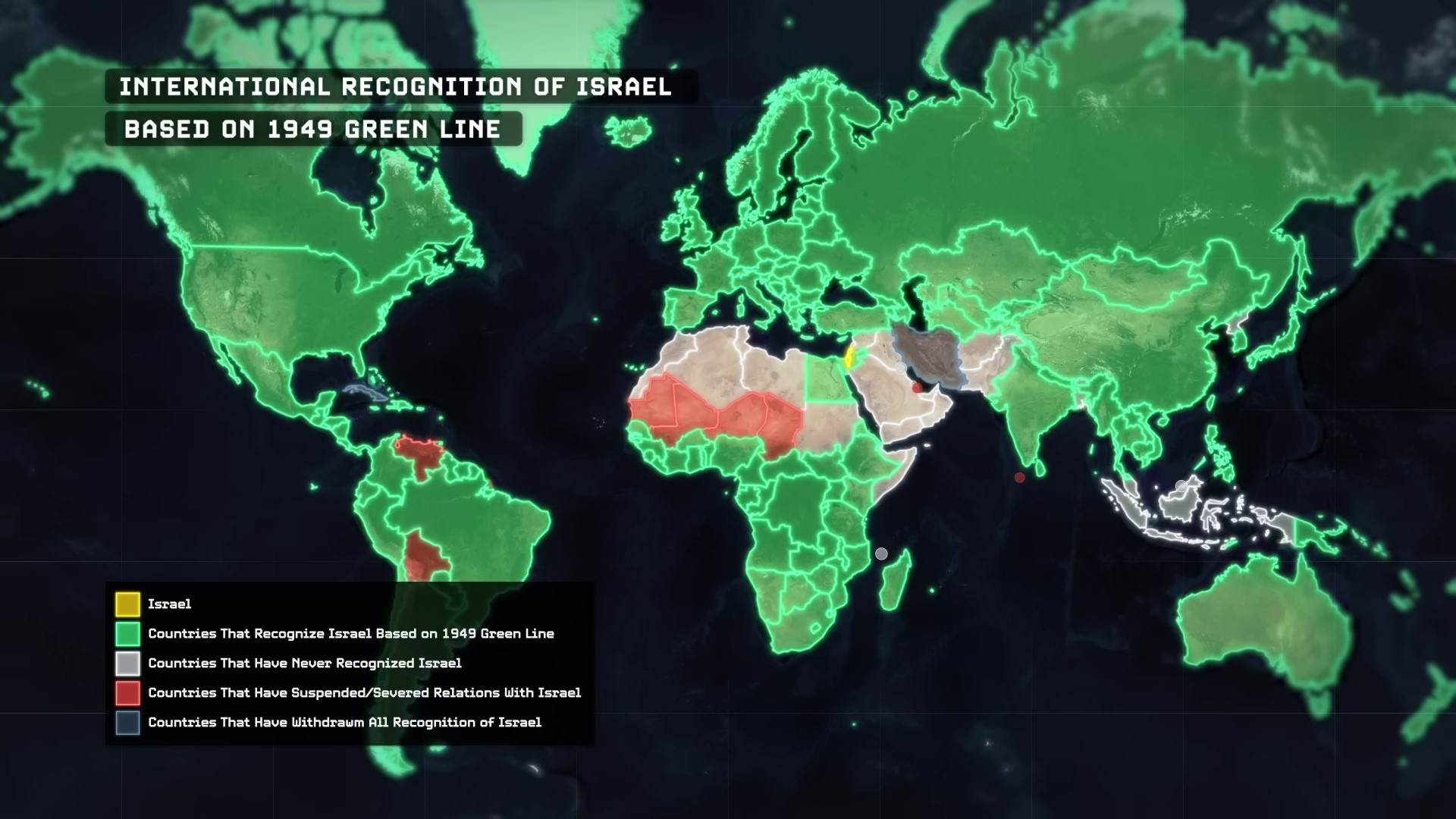
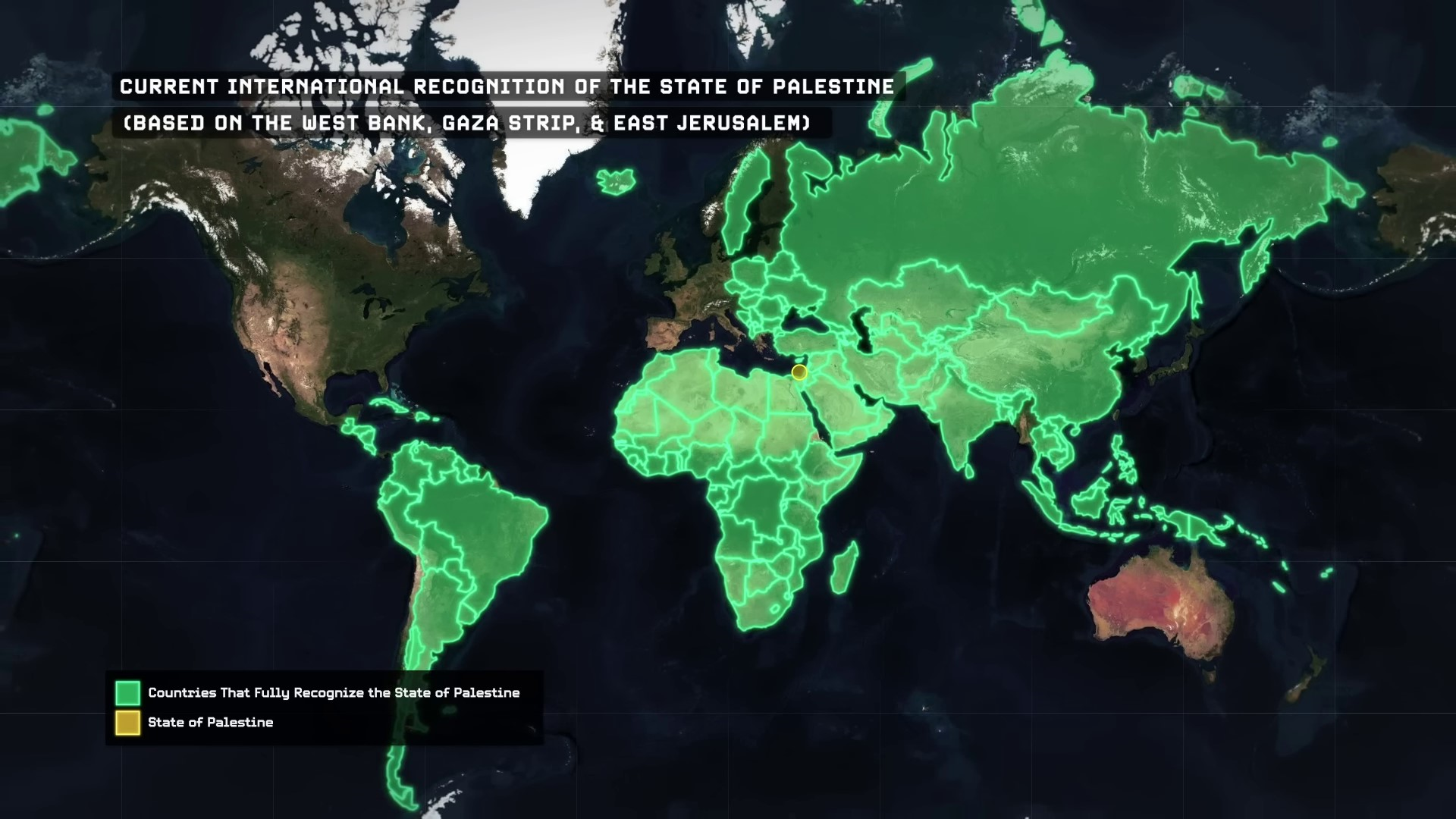
Between 2007 and 2017, the Palestinian Authority’s de jure claims to sovereignty in the West Bank, East Jerusalem, and the Gaza Strip were overshadowed by de facto authority limited to the Palestinian archipelago within the West Bank. The rest of the West Bank and Area C were under Israeli colonial and military rule, East Jerusalem was annexed into Israel, and the Gaza Strip was controlled by Hamas, facing blockades from Israel and Egypt with frequent violence.
There were significant changes in favor of Israel following Donald Trump’s presidency in 2017. Trump recognized Jerusalem as the capital of Israel, leading to international condemnation and protests. The US moved its embassy to Jerusalem, resulting in further unrest and casualties. Israel’s Likud party also pursued the annexation of the West Bank. These actions marked a shift in US policy and escalated tensions in the region.
The United States under the Trump administration chose to officially recognize the 1981-era Israeli annexation of the Golan Heights next in March of 2019, making the United States the first and so far only other country besides Israel itself to recognize the Golan Heights as fully sovereign Israeli territory rather than a Syrian territory under the occupation of Israel. These American recognitions of Israel’s sovereignty over East Jerusalem and the Golan Heights were each continued forward with the Biden administration after 2021 as well, and it has since become a policy that is widely widely viewed by countries all around the world as an act of enormous hypocrisy on the part of Washington, as America has recognized Israel’s unilateral annexations of territories that the entire rest of the world considers to be occupied and which America itself considered to be occupied for decades. Meanwhile America simultaneously has fiercely rejected Russia’s unilateral annexations of territories in Ukraine that are also considered to be occupied like Crimea, Kherson, Zaporizhia, Donetsk, and Luhansk.
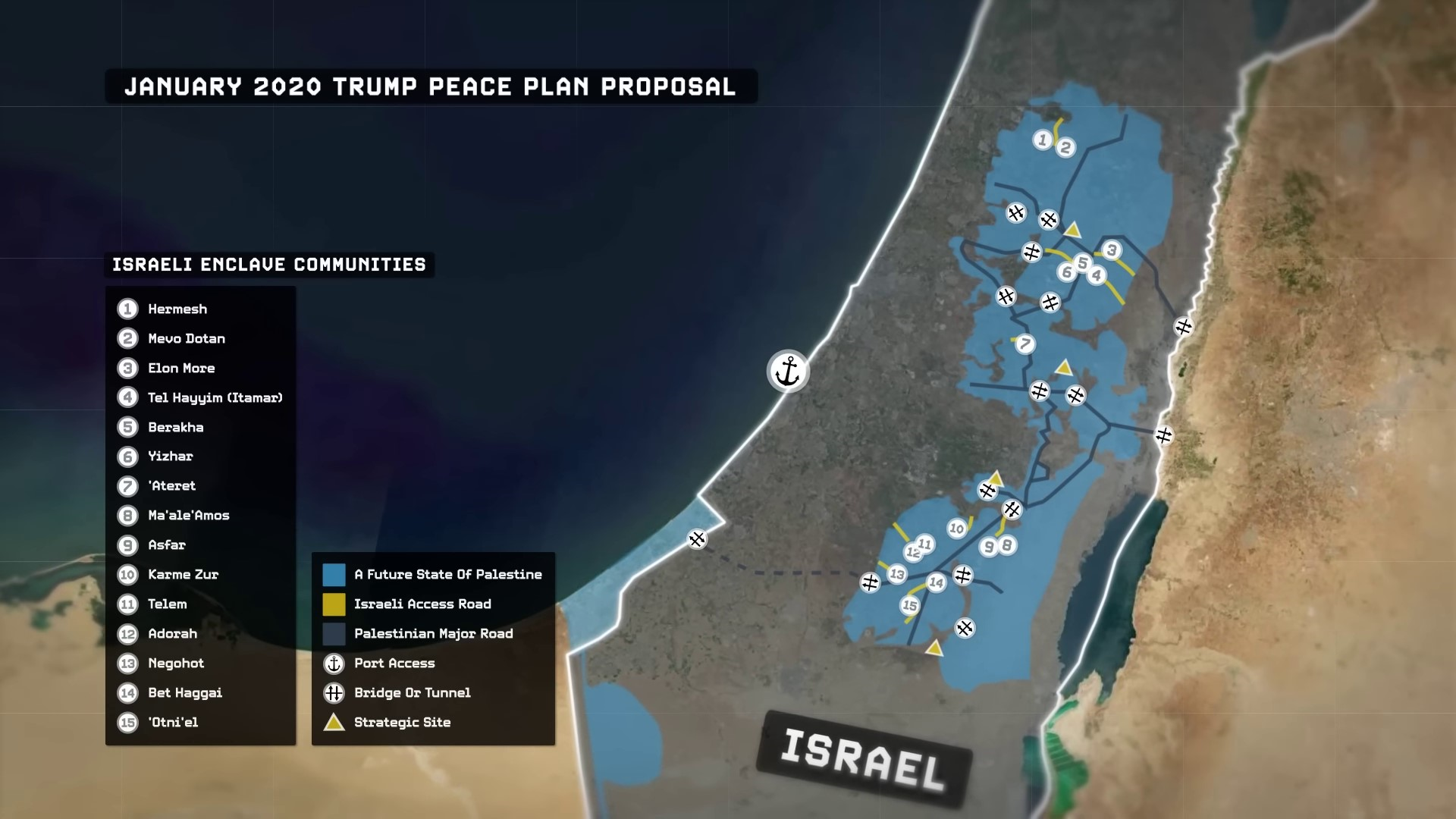
It has since been made apparent to many outside observers that America isn’t actually serious about upholding the norms of international law, but is only interested in selectively applying it to its rivals like Russia when they occupy an annexed territories while ignoring it for their friends and allies like Israel when they occupy and annex territories. Then it was in the following year during a White House press conference on the 28th of January 2020 when the Trump administration alongside the Israeli Prime Minister Benjamin Netanyahu revealed what they each referred to as the deal of the century, better known as the Trump peace plan, the Trump administration’s political proposal to finally resolve the Israeli-Palestinian conflict once and for all. The plan envisaged an independent Palestinian state composed only of various separated enclaves within the West Bank that would continue to be divided and completely surrounded by significantly expanded Israeli territory well beyond the mostly internationally recognized 1949 Armistice Green Line. The plan also completely rejected a Palestinian capital based in East Jerusalem proper, which the Trump administration had effectively recognized as fully Israeli territory back in 2017. Instead, the plan proposed that a new Palestinian capital would be exiled to the outskirts. The plan even further demanded that these limited concessions allotted to a future independent Palestinian state would only be accepted by Israel and the United States if the Palestinian side first agreed to a status of total demilitarization and disarmament and agreed to completely abandon all international legal action against Israel in the United States as well. And then even further during the press conference that was announcing the plan in the White House, Benjamin Netanyahu,
Israeli Annexation of the West Bank: Reactions and Rejections | 0:30:40-0:37:00
The Israeli Prime Minister declared that the Israeli government would be immediately annex the entire Jordan Valley and all of the Israeli settlements within the West Bank. This would have effectively resulted in an Israeli annexation of 30% of the West Bank’s territory, and the third formal unilateral annexation of the Israelis in the post-1967 territories that virtually the entire world beyond the United States in Israel consider to be occupied territories. The 2020 Trump peace plan was ultimately resoundingly rejected by virtually all Palestinians and even many Israelis alike along with most of the rest of the world. Joe Biden and every other leading Democratic 2020 presidential candidate labeled the plan as a smokescreen for the Israeli annexation of the occupied West Bank. The UN rejected the plan and reaffirmed its own commitment to a two-state solution within the former Mandatory Palestine based on Israel’s pre-1967 Green Line borders and a Palestinian state in the entire West Bank, East Jerusalem, and the Gaza Strip. Mahmoud Abbas, the longtime undemocratic leader of the Fatah party and the Palestinian Authority, since he won his only election in 2005, showed a map of the Trump peace plan at the United Nations Security Council that he famously described as turning Palestine into Swiss cheese. And naturally, both his own government in the Palestinian archipelago of the West Bank and his rival Hamas government in the Gaza Strip rejected the plan as being too heavily biased towards the Israeli side.
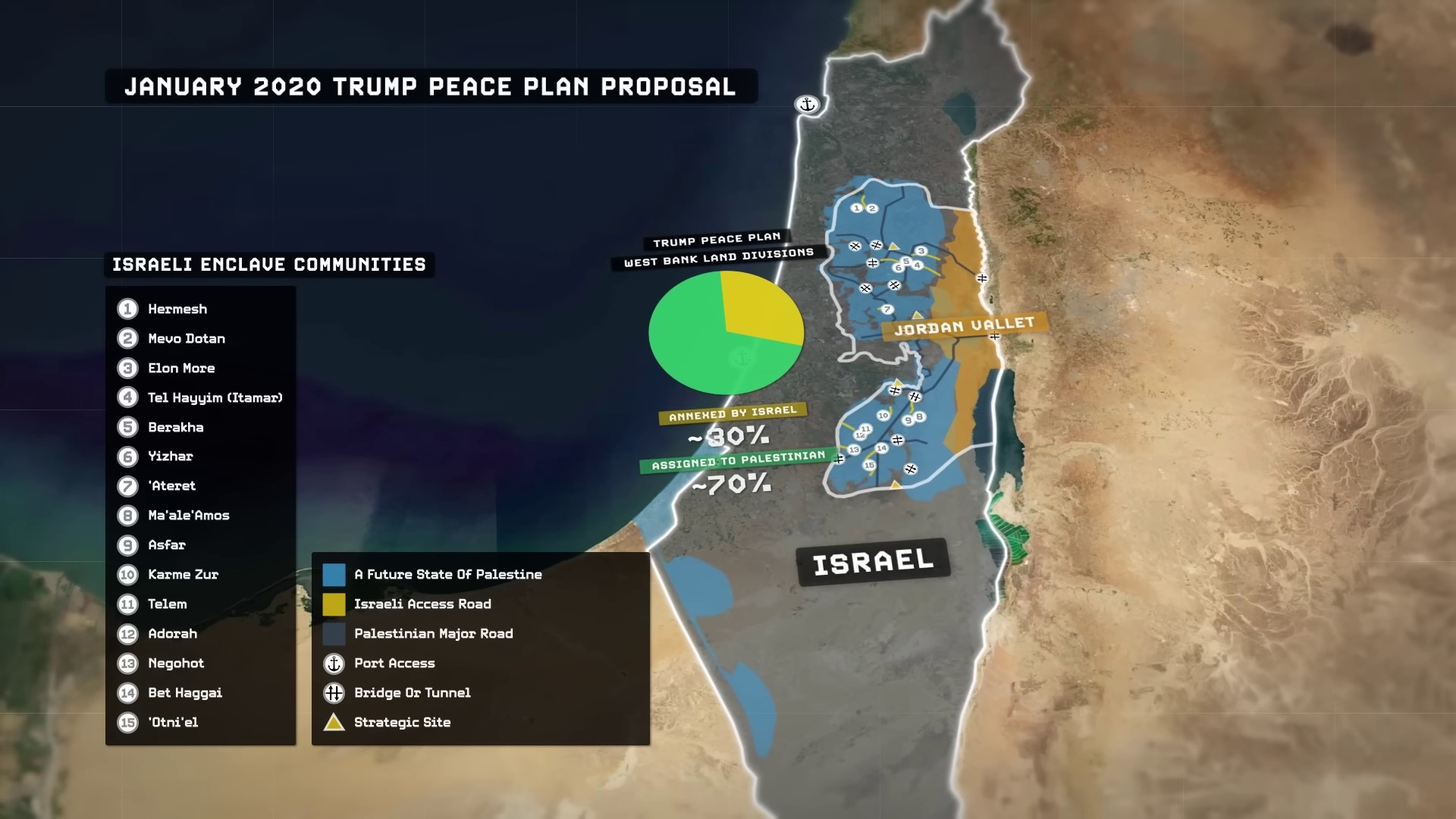
Moreover, even the Israelis’ Yesha Council, an umbrella organization representing the hundreds of thousands of Israeli Jewish settlers in the West Bank, rejected the Trump peace plan as well on the simple basis that it granted the Palestinians an independent state at all, which they were completely opposed to. But as it became clear that the 2020 Trump plan defining an enlarged Israeli state and a shrunken Palestinian state would never be implemented over the vast disagreements on all sides involved, the Trump administration began making significant advances for Israel on the diplomatic front anyway. Behind the scenes, the Trump administration had been mediating negotiations between Israel and the United Arab Emirates, that suddenly resulted in a shocking joint statement between them on the 13th of August, 2020. Israel agreed that they would indefinitely suspend all of their plans for annexing parts of the West Bank like the Jordan Valley and their settlements in Area C, while in exchange, the United Arab Emirates agreed to fully normalize their relations with Israel. Israel, with the first ever direct commercial flights launching between them by the end of the month. It was a shocking announcement, because it represented only the third time in history since the British Mandate to Palestine expired in 1948 that an Arab state had ever recognized Israel, after Egypt had done so back in 1980, and after Jordan had done so in 1994.
From 1994 onwards, for the next quarter of a century, none of the rest of the Arabs would officially break rank and make peace with Israel, sticking on paper to the 1967 Three Nos Agreement that they had all agreed upon back in Khartoum all that long time ago. But now, all of a sudden in the summer of 2020, seemingly out of nowhere, The United Arab Emirates had become the third Arab state overall and the first Persian Gulf state to openly violate the 1967 Khartoum Resolution and make peace with Israel without the final status of the Palestinians being resolved first. And it would be far from the last to do so. In a series of subsequent negotiations that came to be known as the known 5th Arab state to fully normalize their relations with Israel as well. That one was accomplished by Washington offering that, in exchange for Morocco recognizing Israel, the United States would extend its formal recognition to Morocco’s unilateral annexation of the disputed territory of Western Sahara, a territory that Morocco had previously unilaterally declared to completely annex as their so-called southern provinces all the way back in the late 1970s. These southern provinces remained unrecognized by anyone else in the outside world for decades after the annexation, with the United Nations having always considered the Moroccan annexation, like all other unilateral annexations that have come following World War II, to be legally null and void.
After Morocco’s recognition of Israel, the United States became the first country in the world to ever recognize Morocco’s unilateral annexation of Western Sahara, just as it had become the first country to ever recognize Israel’s unilateral annexation of the Golan Heights and East Jerusalem in the couple years beforehand, all of which would ultimately provide even more hefty diplomatic ammunition to countries like Russia to blast the United States with later on, over Washington’s hypocrisy regarding his selective applications of international law. Approving unilateral annexations of UN-recognized occupied territories whenever Israel and now also Morocco do it, but fiercely rejecting it whenever Russia does the same thing in Ukraine. Later in 2023, Israel would return the favor granted by Morocco by becoming the second state in the outside world to formally recognize Morocco’s annexation of Western Sahara as well. And then on January 6th, 2021, on the very same day that a mob of pro-Trump supporters stormed the American Capitol building in Washington, DC, another event of monumental Geopolitical importance was simultaneously taking place over on the other side of the world within the symbolic capital city of Sudan Khartoum, the very location from which the Arab League had previously proclaimed its three nos policy towards Israel more than 53 years previously. A billion dollar loan was taken out to help clear Sudan’s government debt to the World Bank.
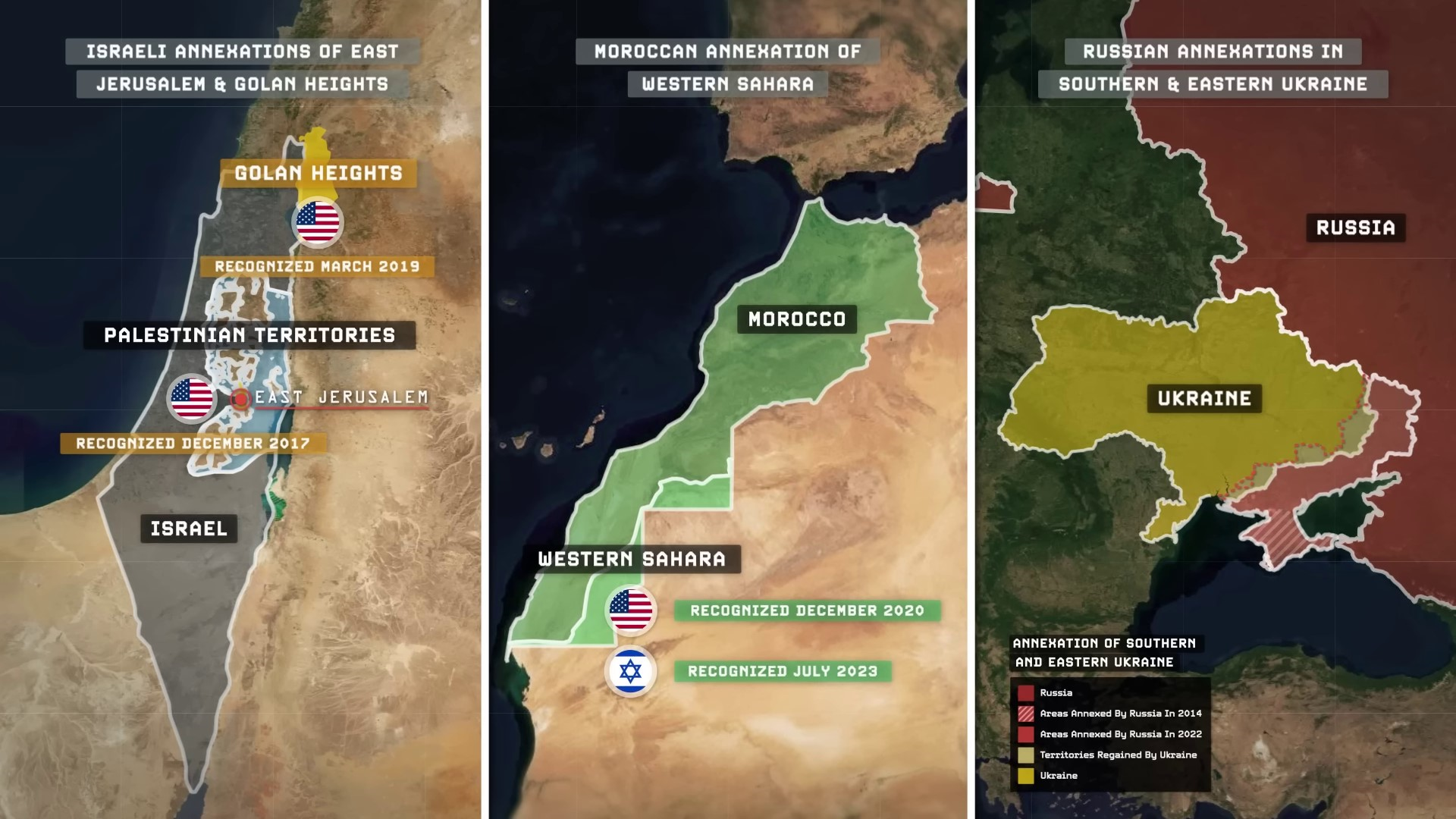
Israel’s Recognition in the Arab World and Palestinian Statehood | 0:37:00-0:45:00
And just like that, the Trump administration was able to increase the pace of Israel’s recognition in the Arab world from only two countries, across 72 years of history, to four more in fewer than five months, bringing the total up to six of them by 2021. And all without the underlying issue of Palestinian statehood being resolved first, that had long prevented Israel’s recognition by any of the Arabs.
By the time the Biden administration assumed office in Washington, it was seeming as if Israel was indeed going to be able to both eat their cake and still have it too. The Palestinians themselves were fully contained, divided, or scattered with an uncompromising Hamas-led government still dedicated to Israel’s total destruction blockaded in Gaza and a mostly cooperative Fatah-led government isolated and divided across areas A and B of the West Bank.
Millions of Palestinian refugees were forcibly displaced across Jordan, Syria, and Lebanon. Within Israel itself, approximately 1.6 million Palestinians constituted a minority, comprising only about 20% of the citizenry. Despite this, Palestinians collectively represented a slight majority, accounting for about 51% of the overall population across the former mandatory Palestine area, with Jews making up approximately 47%. Additionally, there are millions more Palestinian refugees dispersed in countries like Jordan, Syria, Saudi Arabia, Qatar, and Lebanon, who continue to advocate for their right of return to the land from which they or their ancestors were expelled.
The Israeli-Palestinian negotiations have consistently faced a deadlock due to the Israeli refusal to acknowledge a fundamental right sought by Palestinians. With increasing normalization of ties between Israel and Arab states, Palestinians fear that despite their pressing need for statehood, this trend might embolden the Israeli government to annex territories in the West Bank, such as the Jordan Valley and its settlements, or even the entire region. This annexation has long been a goal of various right-wing and far-right Israeli factions, yet they have refrained from acting due to concerns about international backlash. The fear of such repercussions has served as a significant restraint in global diplomatic relations. In 2021, the Biden administration sought to build upon the Abraham Accords by encouraging Saudi Arabia to normalize its relations with Israel. Iran’s foreign policy, under the Ayatollahs, has been centered on uniting the Muslim world while aiming to eliminate Western influences, dismantle Israel, and promote the Islamic revolution. Consequently, Iran has opposed both Israel and Sunni Muslim monarchies. Prior to the Abraham Accords, Iran’s influence in the region was on the rise despite Saudi efforts to counter it, with Hezbollah and Shia militias gaining ground in Iraq and Syria.
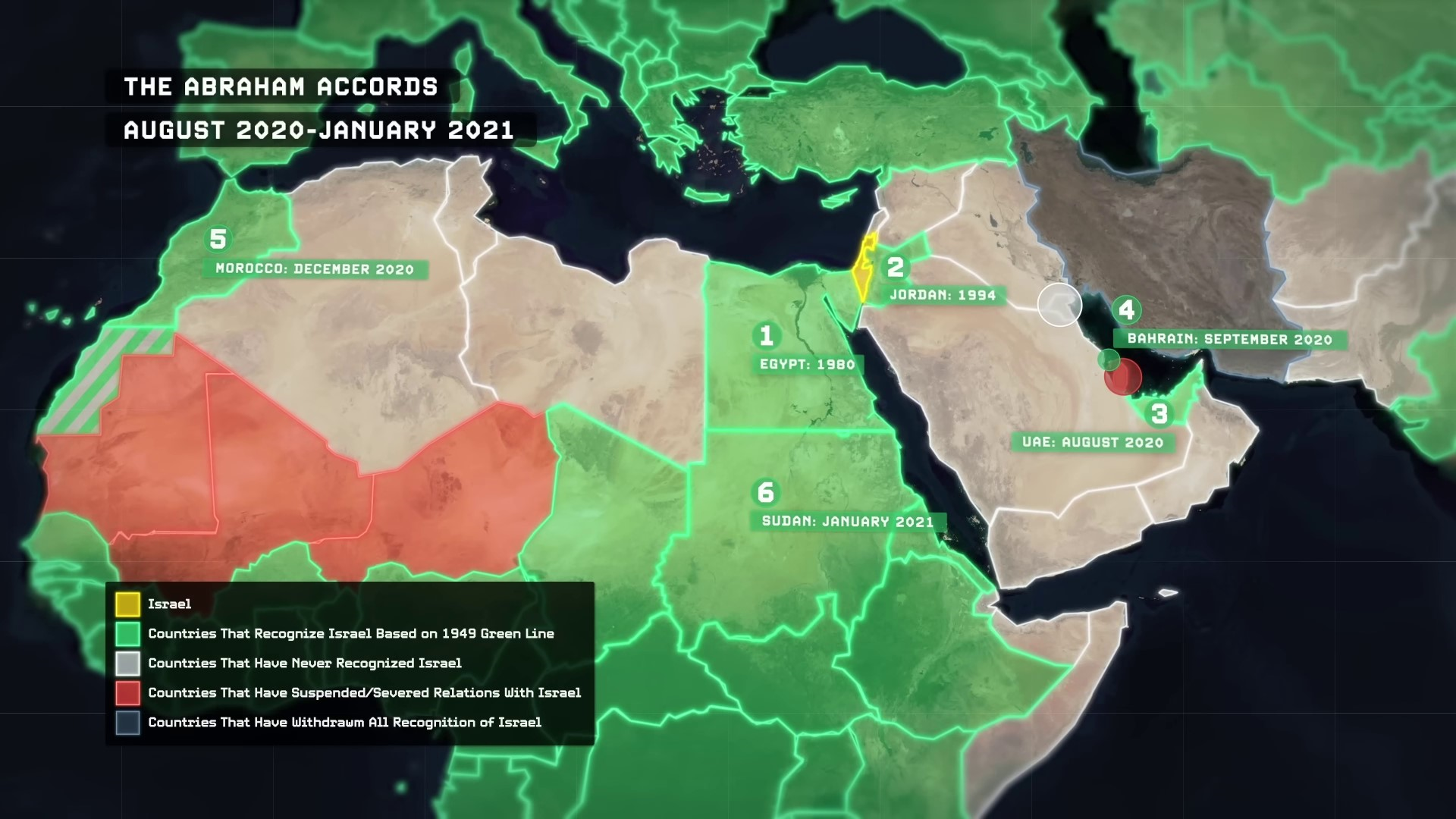
The Gaza Strip, ruled by Hamas, remained a thorn in the side of both Israel and the anti-Islamist regime in Egypt of Abdel Fattah al-Sisi. These pieces were carefully positioned by the Iranians over decades across the board of the Middle East, and represents what Tehran likes to call its axis of resistance. Saudi Arabia was beginning to feel like the axis was encircling them, and then in 2019, Iran itself, or its proxies, even fired cruise missiles at Saudi Arabia that blew up the kingdom’s biggest oil processing facilities at Abqaiq in Quraish. This temporarily knocked half of the country’s oil production offline, but the Saudi kingdom’s historic defender, the United States, refused to retaliate over. After those attacks, the Saudi monarchy quickly calculated, that in order for them to have the best shot at surviving the coming inevitable confrontations with Iran over the rest of the century, they could no longer continue relying exclusively on their status as the world’s biggest exporter and supplier of oil to keep the United States interested in defending them.
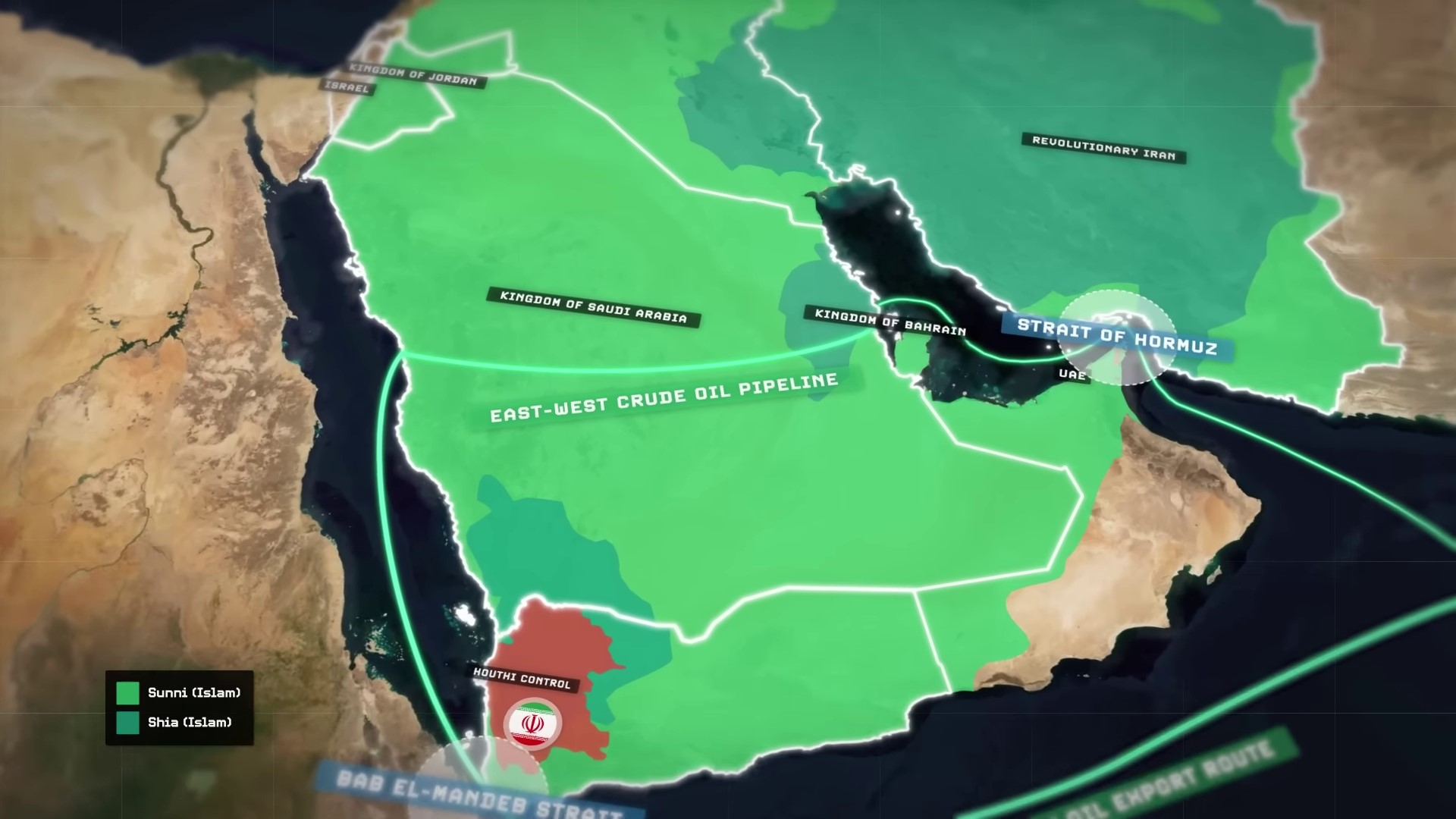
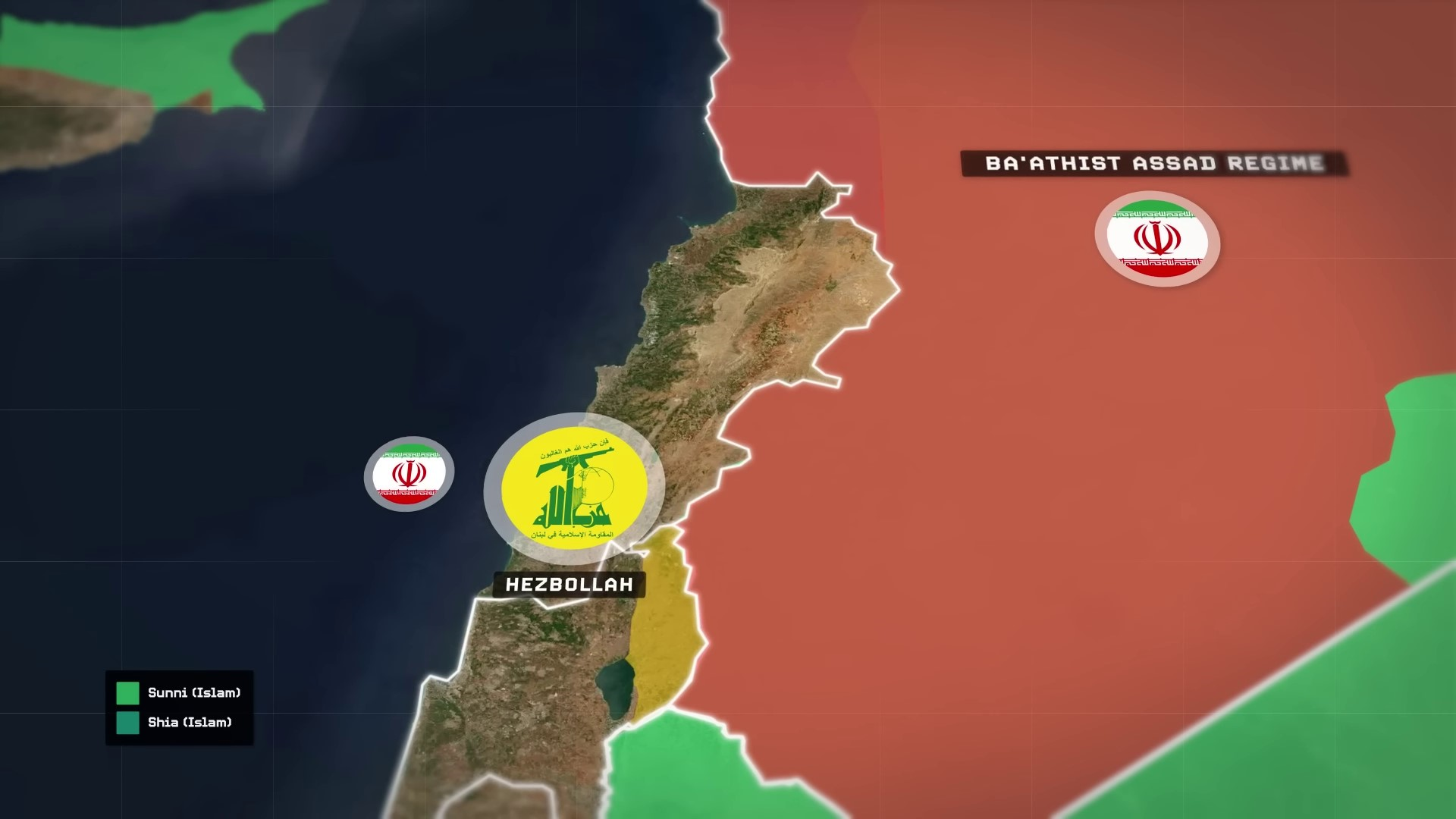
The United States was becoming increasingly self-reliant on their own oil production through the shale and fracking revolutions. The Saudi Monarchy needed to lock down an ironclad mutual defense treaty with the United States, just like the ones Washington has with their closest allies, allies like NATO, Japan, South Korea, Australia, and the Philippines that would legally bind the United States to come to the kingdom’s defense if they were ever to be attacked by Iran or their proxies again. And to help lock that treaty down, they began to also recognize that the enemy of their enemy could also end up becoming their friend. And that friend was potentially Israel, they had long opposed on the basis of solidarity with the Palestinian Arabs, but a country that posed no serious existential threat to the monarchy in the Saudi kingdom, or at least in the same way that revolutionary Iran and its axis of resistance did.
This is what contributed to the Sunni monarchies in the United Arab Emirates and Bahrain agreeing to both recognize Israel with the Trump administration’s mediation in 2020. And it’s been a heavy part of the calculus that has been going on with the Biden administration’s attempts to mediate a further normalization agreement between the Saudis and the Israelis next. And thus, across 2022 and 2023, the Saudis, the Israelis, and the Americans were all negotiating and discussing this process to jointly solve all of their own unique problems of the 2020s.
Going into the negotiations, the Saudis were deliberately, artificially cutting their own oil production lower and lower to the point where their spare oil production capacity reached 3 million barrels of oil per day by October of 2023. Meaning that, essentially within a single month’s notice, the Saudis could, hypothetically, decide to just flip a switch and unleash the spigots and dump an entire Brazil’s worth of oil production onto the world market again, which would, of course, dramatically reduce global oil prices, greatly taper global inflationary pressures and fuel prices leading into the upcoming American presidential election, while simultaneously harming Russia’s ability to continue financing its war in Ukraine.
Geopolitics Between Russia, Saudi Arabia, Israel, and Iran | 0:45:00-0:54:20
Russia heavily relies on oil and gas exports to fund its government and military, and lower oil prices could impact its ability to fund the war in Ukraine. The Biden administration seeks Saudi Arabia to increase oil production, in exchange for a mutual defense treaty and nuclear technology. Cooperation between Israel and Gulf monarchies is desired to focus on countering Russian aggression in Europe and the Chinese dominance in East Asia. The U.S. aims to withdraw from the Middle East and address geopolitical challenges elsewhere.
Iran remains a significant threat, and allies in the Middle East are crucial despite historical tensions over the Palestinian issue. The United States is urging Israel, Saudi Arabia, the United Arab Emirates, and Bahrain to set aside their differences and cooperate to contain Iran and its allies in the Middle East. The goal is for the US to focus on containing China and Russia, while its partners work together against mutual enemies. Saudi Arabia’s recognition of Israel could be a significant development due to its economic power as the world’s leading oil exporter.
Saudi Arabia has the largest economy in the Arab world, dominated by its oil exports. Despite having a smaller population than Egypt, Saudi Arabia’s economy is more than two and a half times larger. It represents nearly one third of the entire Arab League’s combined economy. Saudi Arabia is considered the premier leading Arab state due to its economic power and religious legitimacy as the stewards of Mecca and Medina, the two holiest cities in Islam.
The Saudi monarchy was hesitant to recognize Israel without addressing the issue of Palestinian statehood due to the strong solidarity of their people with the Palestinian Arabs. Riyadh demanded concessions from Israel regarding the West Bank, but the new Israeli government of 2023, composed of right-wing nationalist parties, was reluctant to accept due to their desire to annex the entire West Bank. The government was formed after the November 2022 legislative elections, resulting in the most far-right government in Israel’s history.
Benjamin Netanyahu, leading into negotiations with Saudi Arabia, has faced political challenges within Israel. The shifting demographics in Israel, towards the religious right, are due to higher fertility rates among the most religious sects of Judaism, and this is expected to continue for decades. His 2023 coalition government includes pro-settler parties like Jewish Power and the Religious Zionist Party, advocating for deporting disloyal Palestinians and further annexations in the West Bank. The coalition agreement between Likud and the religious Zionist party in November 2022 highlighted these policies.
Judea and Samaria is the Israeli right-wing term for the West Bank.
In February of 2023, the Israeli Defense Ministry agreed to transfer most of their administrative powers in the West Bank over to a West Bank settler named Bezalel Smotrich, the leader of the Religious Zionist Party and the brand new coalition government’s appointed minister, of Finance. This move effectively appointed Smotrich, an avowed Jewish supremacist who openly opposes any Palestinian statehood at all and denies the existence of the Palestinian people as the de facto governor of the West Bank. And while the move might not have been accompanied by the same kind of pomp and circumstance that went along with Russia’s declared unilateral annexations of occupied territories in Ukraine.
This Israeli transfer of authority in the West Bank from military rule to civilian rule effectively amounted to a quiet, de jure Israeli annexation of the West Bank anyway, and further cemented Israel’s long-term designs on incorporating the territory even further at the expense of the Palestinians, and in contravention to the agreed-upon Oslo Accords of 1993 and 1995. And thus, for Netanyahu to compromise on any plans of further incorporating the West Bank into Israel would mean betraying his own coalition partners who were keeping him in power, which significantly tied his hands on the the negotiations with Saudi Arabia, who was wanting to see at least some symbolic progress against the occupation of the West Bank being made.
But progress was still being made nonetheless, with the Saudi Crown Prince himself saying in September of 2023, mere weeks before Hamas’ attack on Israel, that every day the prospects of ‘all of this build-up’ to war began coming to a head in 2023, when Iran and the Saudis first negotiated a full restoration in their own diplomatic relations in March, with the mediation of the Chinese.
This was a clear attempt by Iran to present itself and its axis as being less threatening to Riyadh in order to dissuade the Saudis from seeing the need to ally any further with Israel. Clearly, Iran does not want its two biggest self-declared enemies in the region, Israel and the Saudi monarchy, actually cooperating together against them. Iran would prefer to divide and conquer, and prevent Israel and the Saudis from being able to cooperate against them. They are easier targets for Tehran and their Axis to work against independently, one at a time, whenever they believe the times is right. Any deal between Tel Aviv and Riyadh that would disrupt that capability would have thus been anathema and unacceptable to Tehran’s regime. Ultimately, as of the production of this video, it’s still not precisely clear if Iran ended up having any direct direct influence or not on Hamas’s attack on Israel that was launched on October 7th.
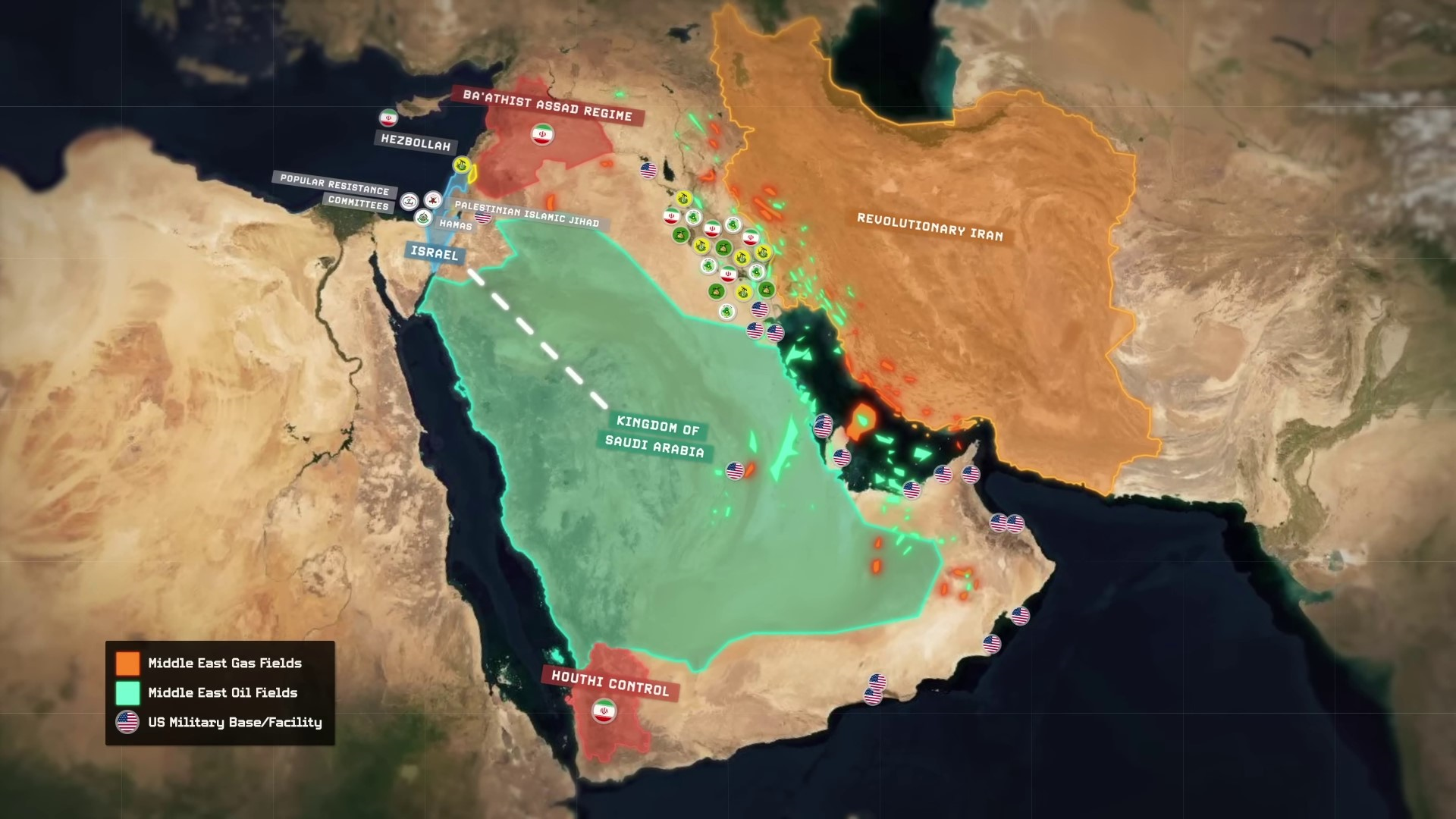
Hamas Roles and Relationships | 0:54:20-0:56:40
Hamas and Iran have a long-standing relationship based on a shared goal of the destruction of Israel, but they have core ideological and theological differences. Hamas is a militant Sunni Islamist and Palestinian Arab nationalist organization, while Iran envisions a pan-Islamist state ruled by Shiite clergy. Despite these differences, Hamas has cooperated with Iran and other regimes in the Axis of Resistance out of necessity for support against Israel.
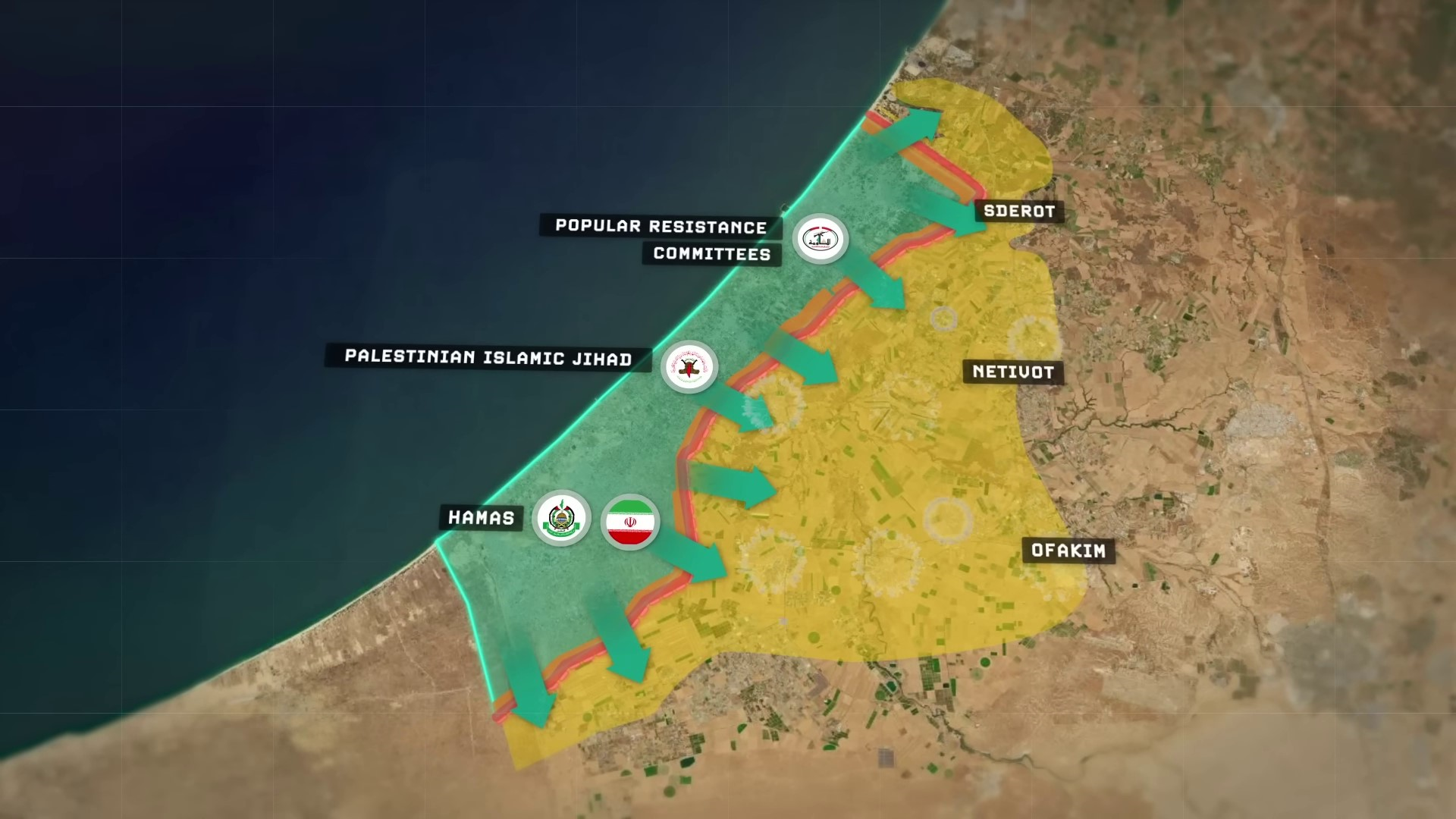
Hamas, recognized as a terrorist organization by the Western world and Egypt, operates as Iran’s pawn but also has its own motives. By provoking Israel with attacks, Hamas aims to disrupt the Israel-Saudi normalization process. This could force Saudi Arabia, seen as a leader in the Arab world, to reconsider relations with Israel amidst Palestinian suffering. Halting normalization could hinder cooperation between Saudis, Israelis, and impact the pace of recognition in the Arab world. This may raise the question of Palestinian statehood in future political discourse.
